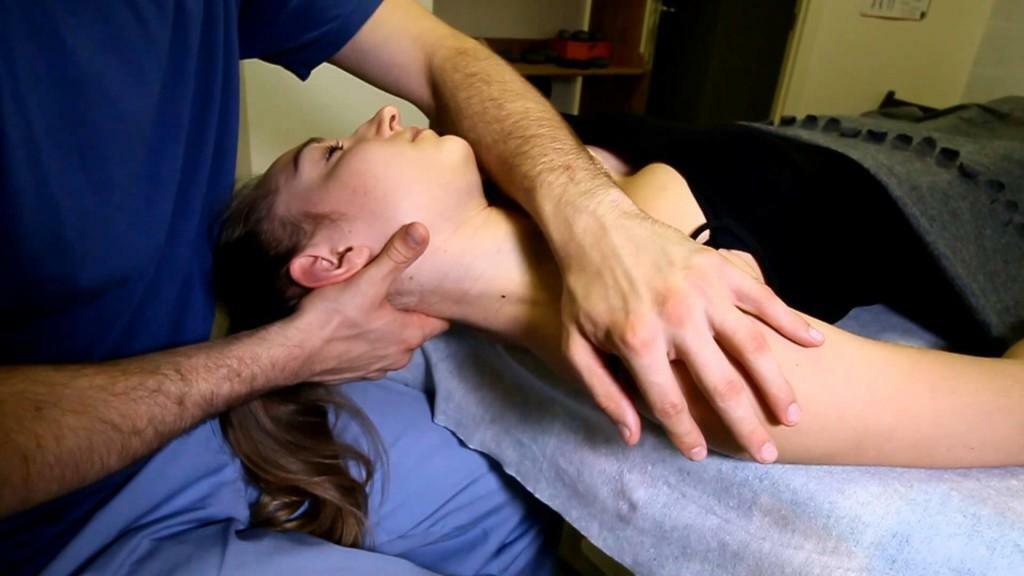The lumbar spine is the most vulnerable part of the human spine, where the hernia usually appears. To understand the mechanism of its occurrence, let us consider briefly the structure of the spine.
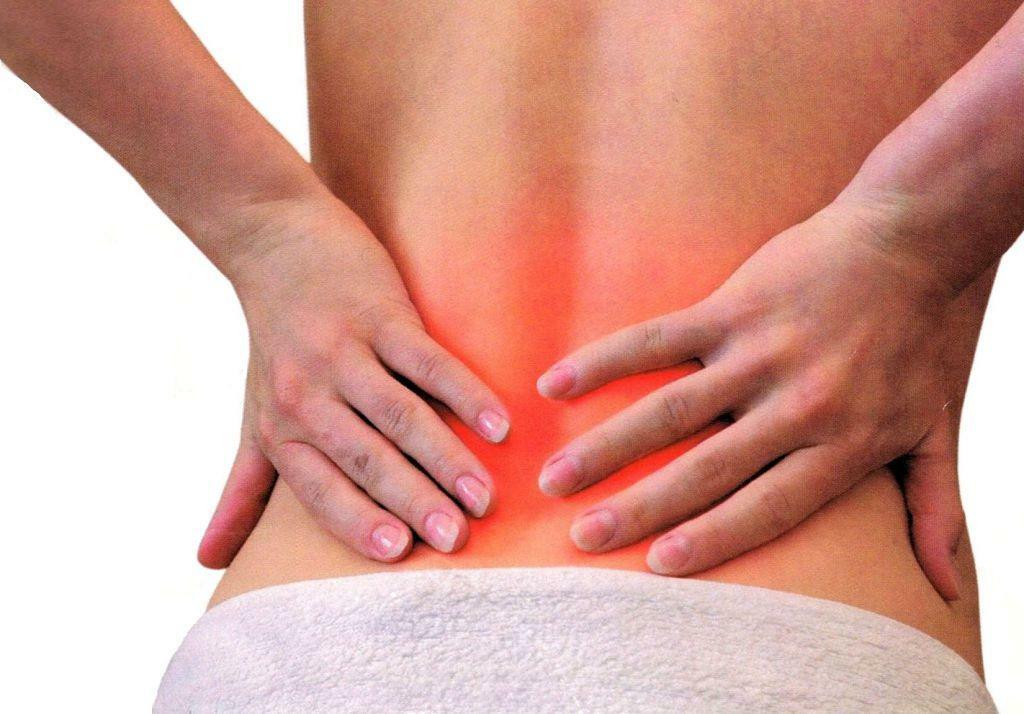
Lumbar hernia, symptoms and treatment
Content of material
- 1 Structure of discs and mechanism of their degeneration
- 1.1 Causes of degenerative processes
- 1.2 Symptoms
- 1.3 Video - Intervertebral hernia: symptoms and signs
- 2 Diagnosis
- 3 Treatment
- 4 Prevention
Structure of discs andmechanism of their degeneration
Bone vertebrae are connected to each other by means of cartilages, called "intervertebral discs".Their main purpose is to soften and evenly distribute pressure on the vertebrae;they spring and absorb the load. The ability of the disks is due to their structure: the oval in cross section of the cylinder has a semi-liquid pulpous core enclosed in a fibrous shell, a structure similar to a tendon. The usual load slightly flatten the discs, they protrude under pressure. This phenomenon is called "protrusion", and under load it is considered normal. Discs do not communicate with the circulatory system of the body. Fluid and nutrition come exclusively through diffusion from surrounding tissues. Therefore, when power is intermittent, dystrophy and degenerative processes begin inside the discs.
IMPORTANT! Not every protrusion is a pregraining condition. Treatment may not be required, just prevention.

Stages of formation of the intervertebral hernia
In particular, these processes affect the fibrous ring, which begins to dry, cracks appear, and the fibrous tissue undergoes defibration. The protrusion described above, which appeared under the load, now becomes constant, and from the moment when a rupture is formed in the fibrous ring, the pulpous mass from the center of the disc is squeezed out( this occurs under the load) into this lumen, forming a hernia pouch. Extrusion of the nucleus beyond the ring was called "prolapse."Over time, this drop can separate itself from the disk - a process called "sequestration."
When extruding the core, the direction in which it occurs is of great importance. The hernia can squeeze the nerve root from the spinal cord and cause painful pain. Can squeeze the canal of the spinal cord, and then the consequences become even more severe. Or go to the other side and proceed asymptomatically, without causing any inconvenience.

Hernia of the lumbar spine
The lumbar vertebra is called a hernia that develops in the corresponding spine section: these are the discs from L1 to S1.However, the frequency of lesions of the hernia of the upper, middle and lower segments is not the same. Most often, the disks are L5 - S1( the last lumbar and first sacral) or L4 - L5( penultimate and last lumbar).The middle segment( L3 - L4) is less often affected, and in the upper segment( L1 - L2), the hernia can only be the result of an injury.
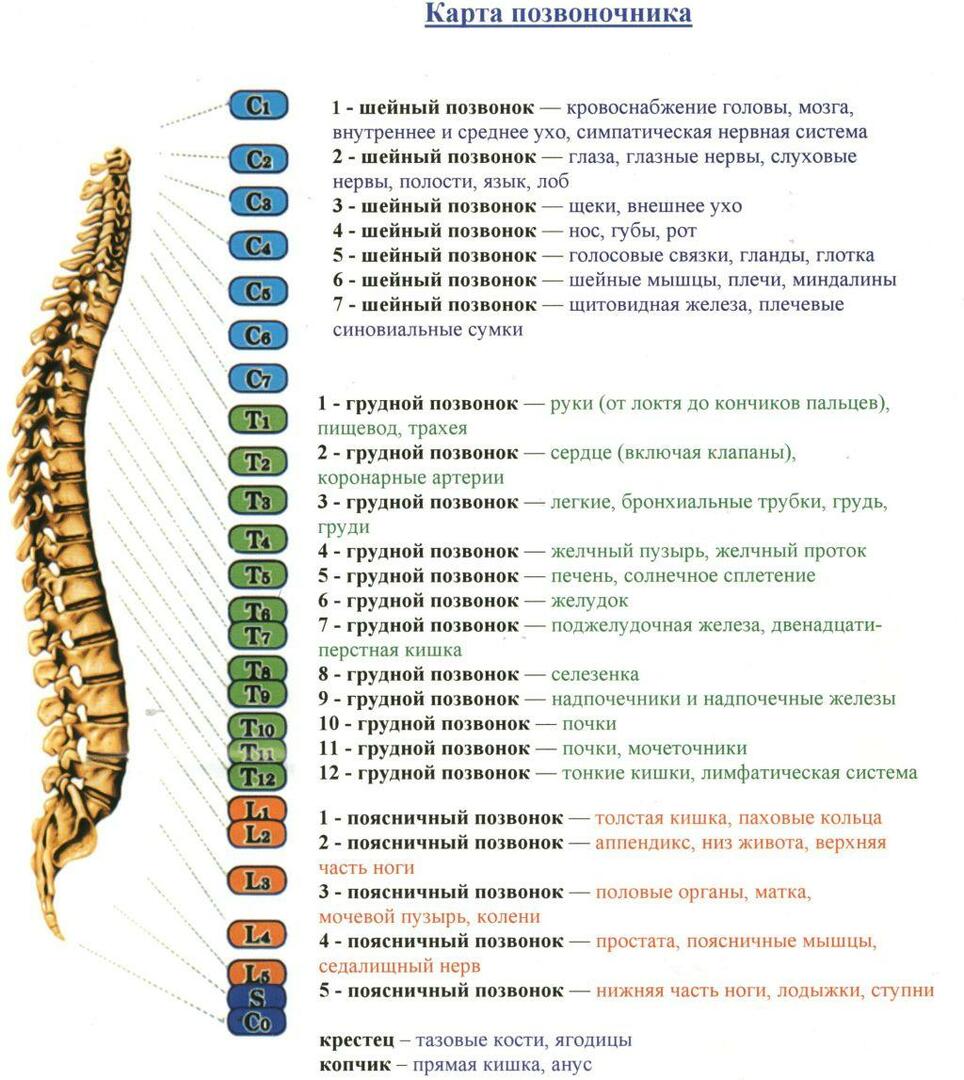
A visual map of the spine
IMPORTANT! Even if you just slipped on the ice and fell - this is an injury, which is worth telling the doctor.
Causes of degenerative processes
In addition to the already mentioned injuries, which in rare cases lead to such an outcome, the causes of disc deterioration and the formation of hernias can be:
- osteochondrosis;
- excessive physical activity;
- insufficient physical activity;
- pregnancy;
- excess weight;
- sudden lifestyle change;
- vegetarianism;
- congenital pathology;
- smoking.
Osteochondrosis can be considered the main disease, the consequence or complication of which is a hernia.
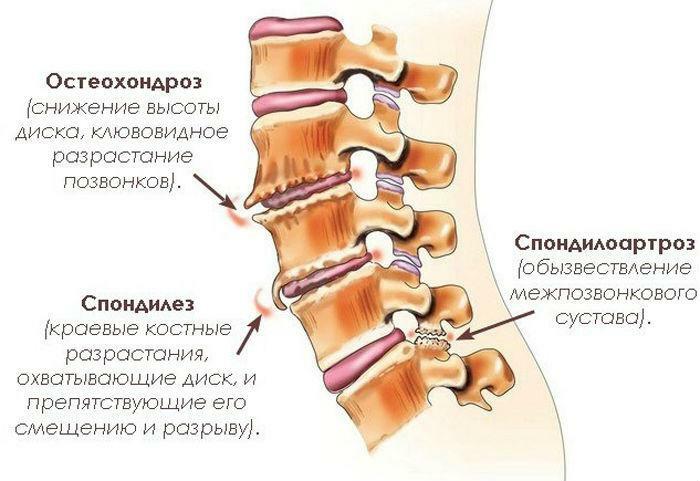
Osteochondrosis is one of the causes of the appearance of the intervertebral hernia
IMPORTANT! Treatment of osteochondrosis at an early stage is a guarantee that in the future you will not run into a hernia.
Let us explain how the excess and lack of physical activity can turn into a hernia. Excessive workload, for example, lifting heavy weights or exercising too much, professional training destroys the discs stealthily, for years. It's not about inadequate nutrition, but in too much pressure on the spine. In the case of hypodynamia, the situation is reversed: the excess pressure on the discs, if it is formed, is from excess weight, and degeneration begins with the fact that low mobility does not give the inflow of nutrients necessary for the discs, because without movement there is no necessary hydrostatic pressure in the spine.
In vegetarianism, the body lacks the required amino acids, smoking leads the tissues to oxygen starvation of the tissues of the whole organism, but in particular, the intervertebral discs also suffer, pregnancy can be equated to a fast weight gain, a lumbar stress, lifestyle changes( sudden transition to activity or hypodynamia)change the usual for the spinal load.
Symptoms of

One of the characteristic signs of a hernia is a back pain
One of the characteristic signs of a hernia is pain .But its nature differs depending on the stage of the disease.
| Initial stage | Middle stage | Started stage |
|---|---|---|
| Outbreaks of pain in the area of the projection of the disc where the hernia appeared. The strength of pain is not yet too great, but the heaviness and perfect sharp movements make it more intense. However, it is worth taking a horizontal position, and the pain goes away. By the morning it again makes itself felt | Instead of flashes, the pain becomes permanent, acquires a aching, dull character. In others, it "shooting".Movement is given not only in the disk with a hernia, but also in what is directly above it. Irregularities on the road are given in pain, as are tapping of the doctor on the spine. Cough and runny nose provoke pain in the back. The lying down position still brings relief, but now it takes several hours for the pain to subside. | Severe pain, which rarely stops for a short while. Any load increases it. Relief brings only painkillers |
Vertebral or vertebral syndrome is the reaction of the surrounding muscles to the constantly arising pain. The muscles contract, and then they remain in this state of spasm. Prolonged tension leads to smoothing of the lumbar lobe( lordosis) until it passes into the stage of kyphosis and scoliosis( persistent curvatures).
| Initial stage | Middle stage | Started stage |
|---|---|---|
| No | First mobility constraints: the waist does not unbend fully | The patient stoops, his body tilts to the side where the source of pain lies. Walking becomes more difficult, there is uncertainty and instability while walking. |
Radicular syndrome or radiculopathy is another sure sign of a started hernia. The depressed nerve roots respond with pain and loss of sensation in the parts of the body associated with them. After a while, the roots may begin to die.

Pain in rooting
| Initial stage | Middle stage | Running stage |
|---|---|---|
| No | Noisy or shooting pain extends below, gripping the space from the buttock to the little finger, but only on the outside of the leg( like the lamp on military trousers).At the same time, the tone of the muscles of the leg decreases, in which pain is felt. Complaints about "cotton feet".Inability to squat, climb on tiptoe, run, jump, etc. You can also feel "goose bumps", cold extremities, excessive sweating, or dry skin of the affected area. | Pain and weakness are worse, even limb paralysis is possible. Muscles atrophy, the leg becomes thinner, it becomes extremely cold, easily damaged. Pelvic organs can not function normally, feces and urine are delayed, sensitivity in the genital area is disrupted |
Video - Intervertebral hernia: symptoms and signs
Diagnosis
After the patient's complaints were collected at the first stage and the first tests for reflexes and muscle strength were carried out,a more serious study of the probable site of hernia location is being made:
- Magnetic resonance imaging of is today the most informative method - with anatomical accuracy become knownSearing and localization of a hernia.
- Computed tomography is less accurate in cases of hernia of the spine.
- In addition, to exclude other diseases, the doctor can prescribe an X-ray study - spondylography .
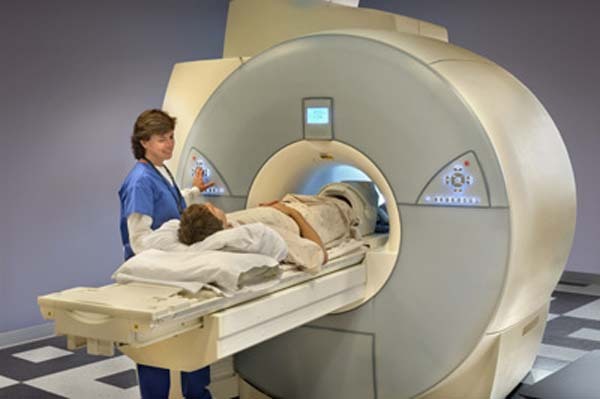
Detection of vertebral hernia with MRI
IMPORTANT! MRI reveals protrusions in many examined. Do not rush to make your own diagnosis.
Treatment of
Acute pain requires urgent measures, but in most cases, doctors start with conservative treatment. And it brings investment to almost three-quarters of patients, harried lumbar hernia.
Conservative treatment of lasts from two to three months. Some need a longer time, but the principle remains the same for all cases: at first doctors only deal with relieving the patient of pain, and then the struggle begins to restore the natural functions of the muscles, spine, and discs.
The first stage - a few days of bed rest and active intake of analgesics and anti-inflammatory drugs of the non-steroid group. In some cases, blockades are prescribed, but this method is not approved by all physicians, because it is necessary to stab in the area of inflammation, and this slows down the recovery.
After a few days it becomes clear: painkillers help or not. If so, the second stage begins: the treatment switches to physiotherapy, massage and gymnastics. If not, then surgery is possible.

Physical exercises with intervertebral hernia
Conservative treatment is a bridge to the patient's future independent care of the health of his back. Having mastered exercise therapy and avoiding exercise, he can prevent relapses of the disease. All this - a change in the motor stereotype, which the body needed so long ago.
Surgery with a hernia is still an extreme measure. The basis for it can be either persistent pain, which "do not take" analgesics, or the fact that the patient begins to refuse internal organs due to a hernia.
Today, surgery to remove the hernia minimally damages the muscles, which contributes to the speedy recovery of the patient. The incision with microdiscectomy is only 3-4 cm. There is an even more gentle operation - endoscopic removal of the hernia, there the incision is even less - up to 2.5 cm, and the patient is at home after 3-4 days, but you can not remove the hernia so farof all patients. The size and location of the object is important.
Prevention
Hernia will not appear if you remember right on time, when your back just starts to ache, or even without waiting for it. It is enough to include in your motor stereotype some or other types of cardio loads - swimming, biking or walking.
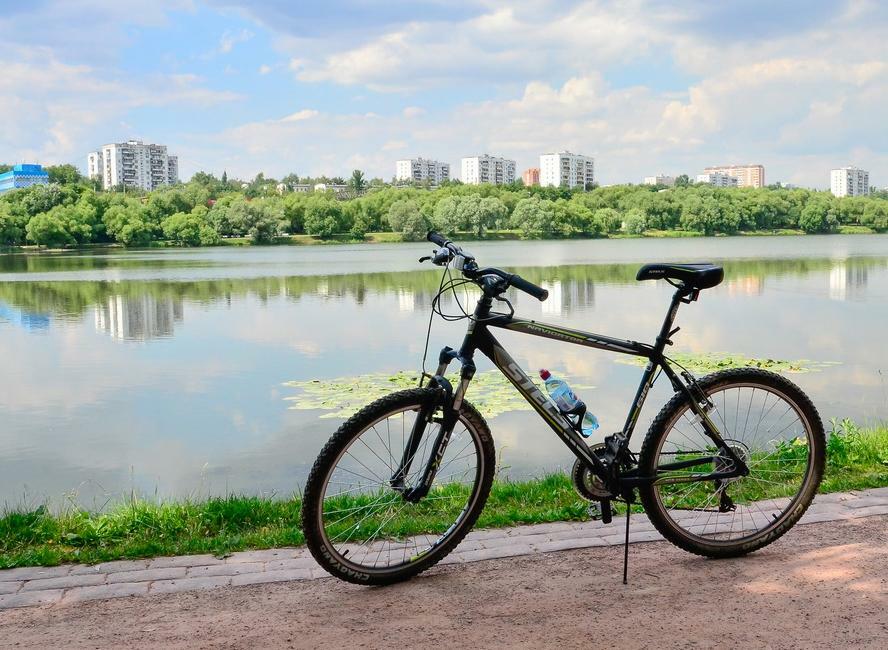
Excellent prophylaxis of the intervertebral hernia is cycling
It is equally important to give up bad habits, especially - from smoking, which damages not only the lungs, but all the muscles and bone tissue of the body, provoking its rapid aging.
Full nutrition can also positively affect the prevention of degenerative processes in vertebral cartilages. Since the body does not produce all its amino acids, some of them must be obtained with animal food.
Professional athletes can avoid the risk of earning a hernia if during training they will follow a uniform distribution of the load. Jerks, twists, sharp turns, as well as lifting weights - movements that should be avoided.
Those who have already been diagnosed with a "lumbar hernia" should undergo comprehensive prevention once or twice a year.
Despite the frightening symptoms of lumbar hernia, modern medicine is able to return a person to an almost full life, after which the maintenance of health is entirely in his hands. But if we were to address doctors early, when the pain is still tolerable, we could expect a full recovery.


